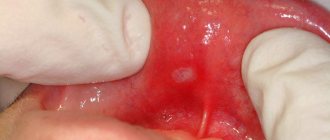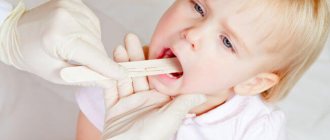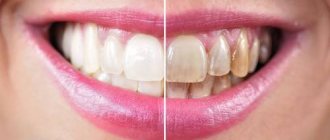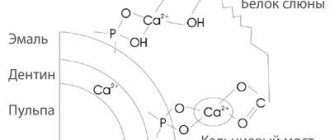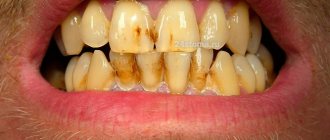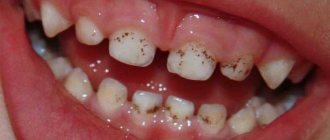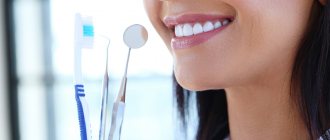Food debris, accumulations of bacteria and saliva form a film that tightly adheres to the enamel, tongue, gum edge and even orthodontic structures. This film is plaque and is called dental plaque. It is impossible to prevent its formation. Within a few minutes after cleaning, plaque begins to form again. In the absence of daily hygiene, the film gradually hardens with the formation of tartar. But even proper regular brushing of teeth does not always prevent the appearance of deposits.
Dentists at the Nurimed clinic will conduct a professional examination of the oral cavity, determine the causes of plaque formation and help get rid of it using innovative technologies and modern equipment. You can make an appointment by phone or by using the feedback form.
Saliva and its role in oral health.
Firstly, saliva is a source of calcium and phosphorus for enamel (remember we talked about remineralization).
Secondly, saliva has a buffer capacity.
The buffering capacity of saliva is the ability to neutralize acids due to the interaction of the main buffer systems of saliva: bicarbonate and
phosphate
Eating carbohydrate foods for a long time reduces, and eating high-protein foods increases the buffer capacity of saliva.
On average, the pH of saliva in the oral cavity of a healthy person is between 6.5 and 7.5.
Slight fluctuations in pH are possible during the day and night (slightly lower at night).
An adult produces an average of 1500 to 2000 ml of saliva per day.
The rate of secretion depends very much on many factors - age, food irritant (I saw my favorite dish and even salivated, nervous excitement.
During sleep, saliva is secreted 8–10 times less.
The high buffering capacity of saliva is one of the most important factors that increases the resistance of teeth to caries.
The components of saliva make up the pellicle - a thin film that covers all surfaces of both hard and soft tissues of the oral cavity.
The pellicle has many tasks, including regulating the microbiota of the oral cavity.
The deposition of cells and food debris from saliva onto the pellicle leads to the formation of dental plaque - a loose white substance made of bacteria, desquamated epithelium, leukocytes and food debris.
The compaction of a pellicle in a certain place and the accumulation of bacteria there is a bacterial plaque, the source of caries.
Now, with an understanding of what saliva is needed for and what a pellicle is, let’s return to the topic of plaque.
Teeth cleaning
How to prevent deposits from appearing? Follow the advice of dentists:
- Pay more attention to the inside of the front teeth. Clean from top to bottom using short strokes with the brush positioned vertically.
- Cover only 2 teeth at a time.
- The length of the brush should be such that you can reach the wisdom tooth.
- Use dental floss to clean between your teeth.
- Change the brush once every 2 months.
- Choose a brush with medium-hard bristles.
- To rid your mouth of microorganisms, be sure to clean your tongue.
- For sufficient salivation, drink more clean water.
Which leads to a change in the color of the enamel.
Sometimes the tooth is already growing with spots due to some internal reasons.
But more often spots appear due to staining of the enamel or pellicle from the outside.
A very well-known option is teeth staining while taking medications such as iron or de-nol, which is popular among gastroenterologists.
But often plaque appears without any obvious external influence.
The most famous option is Priestley's plaque or, as it is called in English literature, “black stain”.
Causes of white plaque
A white rim near the gums appears from poor hygiene. But if you don’t pay attention to it, the process of decay will soon begin, especially between the teeth. It won’t take long for caries, stone formation, and gum inflammation to appear.
How to remove white plaque between teeth? The proposal is not new:
- brushing teeth twice a day;
- rinsing after every meal;
- use of dental floss;
- introduction of solid vegetables and fruits into the diet.
It is worth paying attention to the state of the endocrine system or gastrointestinal tract. Diseases of these systems can also cause the appearance of a white layer.
If a child has white spots on his enamel, then give him a carrot or an apple instead of sweets. Chewing solid food will help remove the unsightly white spot.
If the white layer is not removed, then it must be removed in dentistry. You will be offered an ultrasound procedure that will help restore the natural color and remove the stone. There are other professional techniques, for example, Air Flow technology. This technique is based on the impact of an aerosol jet containing a cleaning agent on problem areas. Then each tooth is polished individually.
What is Priestley's plaque?
This plaque looks like black specks or lines of specks along the neck of the tooth. Plaque is quite tightly attached to the surface of the tooth and is difficult to clean with a regular brush.
It is usually found in children, although it can occur in adults.
There is no evidence that this plaque is somehow related to the pathology of the gastrointestinal tract.
This plaque is called bacterial, and for good reason: if you look at the plaque, it turns out that these are plaques created by a community of special bacteria, with a predominance of Actinomyces (Actinomyces naeslundii).
Black plaques have higher calcium and phosphate contents than uncolored plaques.
The black color is the result of the interaction of iron and copper ions (they are in our saliva) and hydrogen sulfide, which is released by plaque bacteria - the same actinomycetes.
Treatment, elimination and prevention
For adults
Preventive measures will help prevent the formation of bacterial film:
- regular brushing of teeth - at least twice a day (in the morning and before bedtime);
- flossing and rinsing your mouth after every meal;
- limiting the consumption of coffee, strong tea and other “colored” drinks;
- excluding smoking.
- When choosing a brush, pay attention to its size - a small product will allow you to clean teeth that are located deep. The bristles should have medium hardness and a rounded shape - this will prevent injury to the gums and the appearance of micro-scratches on the enamel.
- Rubber inserts present in the design of some types of brushes will help increase the efficiency of plaque removal. The use of such products is advisable for people who are prone to the formation of tartar or smokers.
- Plaque can be removed using a paste with antibacterial components and an abrasiveness rating of 100 to 250 conventional units.
- To remove the orange film from the interdental space, floss is suitable: lower the floss between the teeth to the base of the gums and gently lift it up.
- Use elixirs with bactericidal properties as a rinse after meals.
- An irrigator or chewing gum enriched with calcium and containing no sugar works well to remove deposits.
It is impossible to remove mineralized plaque or tartar at home, so you need to contact a dental clinic.
Methods for professional teeth cleaning:
- Using ultrasound, waves are sent through a nozzle, affecting the enamel and the area located under the gums. The deposits are crushed into small pieces and then washed away.
- The sandblasting method involves removing bacterial plaques with a soda solution, followed by treating the teeth with an abrasive paste and coating them with fluoride varnish.
- Laser cleaning – suitable for people with weak enamel. Unlike ultrasound, the procedure is performed without laser exposure directly to the surface of the teeth; radiation is destructive for microorganisms and allows you to remove deposits of any hardness.
- Photo-whitening – the breakdown of the coloring pigment occurs due to active oxygen, which is released from the gel applied to the teeth under the influence of a special lamp.
For children
Preventive measures:
- Daily brushing of teeth, starting from the moment the first units appear.
- A balanced diet, enriched with solid foods and excluding the use of sugary foods and food dyes.
- Visit the dentist at least 2 times a year.
- Before the age of 1 year, the child’s teeth are wiped with a piece of lint-free cloth soaked in warm water; starting from 2 years, the child should have a personal brush with soft bristles and a special rubber attachment to clean the mucous membranes of the mouth and the surface of the tongue. The brush should be changed at least once every three months.
- To carry out the procedure for cleaning plaque from teeth, you should use a paste with an abrasiveness of no more than 20 conventional units (for children under 4 years old), 50 units (for children over 4 years old) and a limited fluoride content: up to 4 years old - 200 ppm; from 4 to 14 years 500-1400 ppm.
- In the process of caring for a child’s oral cavity, the use of an irrigator is allowed, but the technical characteristics of the device must be age-appropriate.
If it is impossible to remove plaque at home, you should contact your dentist for professional procedures:
- Cleaning with abrasive paste and a circular brush with sanitation of the oral cavity.
- Sandblasting method followed by application of fluoride-containing gel (the procedure is indicated from 7 years of age) ultrasonic cleaning – not carried out on baby teeth, the use of a scaler is desirable from 12-14 years of age.
The best way to avoid the appearance of pigmented plaque is to prevent its formation by giving up bad habits, normalizing your diet and carefully observing oral hygiene. Such preventive measures will eliminate the development of caries and inflammatory processes in the oral cavity.
How common is Priestley's plaque?
According to various sources, from 2.4 to 18% of people experience this plaque.
Plaque is found equally often in boys and girls.
The dependence of the frequency of plaque on the nature of nutrition and the level of oral hygiene is not yet clear.
Taking iron supplements by a child or even his mother during pregnancy makes plaque more likely.
Several authors have proposed their classifications of black plaque according to severity.
Encouraging fact: When the dentist removes plaque, there is usually good, strong, healthy enamel underneath. Most scientists believe that the presence of Priestley plaque even reduces the risk of tooth decay.
Studies have shown that the saliva of children with Priestley's plaque typically has a higher concentration of calcium and a buffer capacity - that is, the ability to resist acidification. Perhaps this fact explains the lower risk of caries.
As I mentioned, bacterial plaque doesn’t just affect children.
The photo below is a real clinical case, and not the actor’s preparation for filming the new part of Mad Max.
The photo shows a 60-year-old man with no bad habits and good oral hygiene.
The cause of his plaque turned out to be the bacterium Prevotella melaninogenica .
This bacterium may be part of the normal oral flora, giving the distinctive black color to plaque, especially in children. The bacterium produces hydrogen sulfide, which interacts with iron found in saliva. The result is black staining of the teeth and tongue.
In this case, she chose the oral cavity of an adult man.
By the way, this man still managed to get rid of plaque with the help of dentists and regular dental hygiene.
What can plaque on teeth be confused with?
Areas of enamel may appear yellowish due to severe erosion and dentin showing through
And teeth can also be green...
How is plaque formed?
First, soft plaque forms on the teeth, the formation of which consists of three stages:
- A couple of minutes after the end of cleaning the oral cavity, active reproduction and spread of bacteria throughout the oral cavity begins. The process takes 4 hours, after which the number of bacteria reaches a million.
- Over the next 3 hours, the bacteria attach to the surface of the tooth enamel and form a soft film. After fixation, microorganisms begin to release substances that destroy the enamel, causing carious lesions to develop.
- When 8 hours have passed after cleansing the oral cavity, deposits become visible and structured. The majority of bacteria in them do not require oxygen.
The resulting film progressively thickens and becomes denser. hard plaque forms within a day after the last brushing. The formation of tartar is typical for surfaces that have little contact with the tongue and food.
Conclusion:
Typically, dental plaque has nothing to do with the pathology of the gastrointestinal tract.
I had separate observations that plaques (not like Priestley’s plaque in appearance) decreased in parallel with the treatment of reflux in children with specialized complaints, but global conclusions cannot be drawn from this.
If the dentist, when trying to clarify the cause of plaque that forms too quickly, reveals dyspeptic complaints and some suspicious symptoms (sour breath, thick coating on the tongue), a referral to a gastroenterologist seems quite logical.
5, total, today
Getting rid of black deposits on enamel
How to remove black plaque? If possible, it is better to go to a clinic where there is special equipment, such as a laser or ultrasound. Not all people have this opportunity.
At home, problem areas can be rubbed with a mixture made from activated carbon and hydrogen peroxide twice a week.
Many people praise the mixture of grated radish and lemon juice . The resulting pulp must be chewed for a long time and then spat out. Try rinsing your mouth with a honey solution (1 teaspoon of honey per cup of water). Treatment continues for at least 5-6 months.
A good effect is achieved by using tea tree oil. This product can be used without harm to the enamel, unlike other aggressive substances.
What oral problems can tea tree oil help with:
- Elimination of the inflammatory process in the gums.
- Removing tartar without the use of medical instruments.
- Prevention of caries.
- Eliminating bad breath.
How to brush your teeth with oil? You can add 2 drops to the toothpaste on your toothbrush. Make a rinse aid by dropping 2 drops into a glass of mineral water. To dissolve the stone, you can lubricate the internal cavity, then rinse your mouth.
You shouldn’t get carried away with such procedures either. The course of treatment is 1 week. For prevention, manipulation is carried out once every 2 weeks. This is an incredibly powerful healing method. You will get rid of gum disease and tartar!
Attention! After bleaching, you should not eat for 2-3 hours. The unpleasant numbness of the tip of the tongue quickly passes.
For sensitive coverage, prepare a healing remedy consisting of 2-3 drops of ether and 1 tsp. aloe juice Rub this mixture into your enamel and gums, and you will soon get rid of many oral problems.
How does the procedure for removing black plaque on teeth work?
Reliably and safely getting rid of dark spots on enamel is possible only with a professional dentist. Self-removal of black plaque in children using various folk remedies can lead to damage to the surface of the teeth.
Therefore, you should not self-medicate, but it is better to immediately use the services of specialists. At the Esculapius clinic we will find the root cause of the violation of the natural microflora of the mouth and eliminate the aesthetic defect from the enamel. At the same time, we use only effective methods that guarantee the highest quality results.
To treat Priestley's plaque, the Air Flow device is used, as well as ultrasound. During the procedure, a mixture of water, air and soda crystals is sprayed onto the teeth under pressure. The flow removes various types of deposits not only from the surface of the tooth, but also from the interdental spaces.
For children who do not really like brushing their teeth using the Air Flow method, soft plaque is removed with special brushes and pastes. After professional cleaning, the teeth are polished and become smooth, due to which less plaque settles on the enamel.
This procedure is available in our clinic at a reasonable cost. In addition, it is inexpensive to perform silvering of baby teeth - a preventive measure to strengthen the enamel and protect against caries, as well as other hygiene procedures. With us, your child's smile will be healthy and beautiful.
